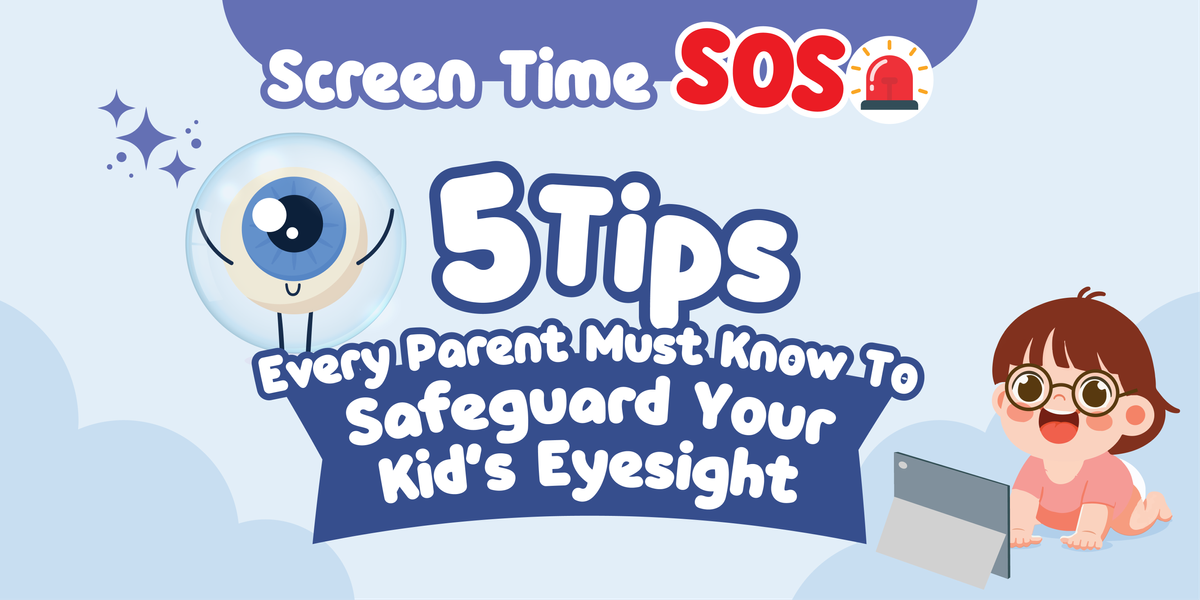
In today's digital age, screens are an inevitable part of our children's lives - from TVs to smartphones to tablets to computers. While offering entertainment, education, and help us stay connected, too much screen time can be harmful, especially for children's eyesight. As parents, it’s essential to be aware of the potential negative effects of blue light exposure emitted from the screens.
What is blue light?
Blue light is a bright, artificial light that comes from screens like TVs, smartphones, tablets, and computers. It's everywhere, especially in today's digital world! While it helps us see things on our screens, too much exposure can cause more harm than good, impacting our eyes and overall health.
How does blue light affect our child’s vision & health?
Think of it like the sun – it's good for us in moderation, but too much can be uncomfortable.
Blue light can cause oxidative damage to the delicate eye cells and lead to a range of eye problems, including eye strain, dry eyes, and blurred vision.
Children are susceptible to blue light as they have large pupils and pure crystal lenses.1 They might easily experience symptoms like headaches, eye irritation, and trouble concentrating.
Study has found that children exposed to screens before age 3 are more likely to have developed myopia by pre-school age.2 Myopia is an eye condition which causes blurred far vision, and is also known as short-sightedness or near-sightedness.
Blue light can also disrupt the body's natural sleep-wake cycle by suppressing the production of melatonin and keeping children awake,3 thus affecting their overall well-being.
How much is fine?
With the potential risks in mind, you’re probably wondering how much screen time is fine. While there are many opinions, most experts agree that less screen time is better, especially for infants and toddlers. The American Academy of Child & Adolescent Psychiatry recommends the following guideline:
(American Academy of Child & Adolescent Psychiatry, 2020)
Eye-ing for protection?
Try these 5 simple tips to mitigate the negative effects of excessive screen time in children:
Set limits on screen time
Establish clear rules regarding screen time, and be consistent in enforcing them.Follow 20:20:20 rule
For every 20 minutes of screen time, take a 20-second break to look at least 20 feet away.Be a role model
Demonstrate healthy screen habits by limiting your own screen time and engaging in other activities.Your children are more likely to follow your example.
Encourage alternative activities
Offer a variety of activities to keep them engaged and entertained without screens such as outdoor play, creative pursuits or reading.Incorporating eye-protecting foods
Foods that contain antioxidants and vitamins like anthocyanins, flavonoids, zeaxanthin, vitamin C and beta-carotene are some great additions to help relieve the common screen time eye symptoms and increase their eyes’ natural protection against dangerous blue light.
Why DDODDOMAM Bilberry & Berries Jelly?

Incorporating DDODDOMAM Bilberry & Berries Jelly into your children's diet can provide additional support for their vision health. DDODDOMAM Bilberry & Berries Jelly offers a delicious and convenient way to nourish their little eyes.

This specially crafted DDODDOMAM Bilberry & Berries Jelly packed with mixed extract of eight antioxidant-rich ingredients and essential vitamins, including bilberry, blueberry, blackcurrant, goji berry, aronia berry, carrots, cassia seeds, and marigold flower. These ingredients are known for their eye-protecting qualities, helping to combat the oxidative stress caused by screen time and promote healthy vision.

Let's take proactive steps to protect our children's eyes and ensure they can see the world clearly for years to come. Interested to know more about DDODDOMAM Bilberry & Berries Jelly? Read HERE.
References
Higuchi, S., Nagafuchi, Y., Lee, S.-i., & Harada, T. (2014). Influence of light at night on melatonin suppression in children. The Journal of Clinical Endocrinology & Metabolism, 99(9), 3298–3303. https://doi.org/10.1210/jc.2014-162
Yang, G. Y., Huang, L. H., Schmid, K. L., Li, C. G., Chen, J. Y., He, G. H., ... Chen, W. Q. (2020). Associations between screen exposure in early life and myopia amongst Chinese preschoolers. International Journal of Environmental Research and Public Health, 17(3), 1056.
Hale, L., & Guan, S. (2015). Screen time and sleep among school-aged children and adolescents: a systematic literature review. Sleep medicine reviews, 21, 50–58. https://doi.org/10.1016/j.smrv.2014.07.007
American Academy of Child & Adolescent Psychiatry. (2020). Screen Time and Children. Retrieved from https://www.aacap.org/AACAP/Families_and_Youth/Facts_for_Families/FFF-Guide/Children-And-Watching-TV-054.aspx




